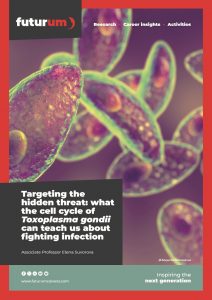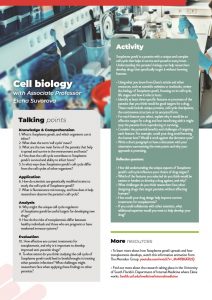Targeting the hidden threat: what the cell cycle of Toxoplasma gondii can teach us about fighting infection
Toxoplasma gondii is a microscopic parasite that infects nearly every warm-blooded animal on Earth – including humans. Although many people carry the parasite without knowing it, Toxoplasma gondii can cause severe illness in unborn babies and those with weakened immune systems. At the University of South Florida in the US, Associate Professor Elena Suvorova is studying how this parasite reproduces at the cellular level to identify weak points that could lead to new anti-parasitic treatments.
Talk like a cell biologist
Centrosome — a structure inside cells that helps organise and control the process of cell division
Cell cycle — the process by which a cell grows, copies its DNA and divides to form new cells
Checkpoint — a control point in the cell cycle that ensures each step happens correctly before the next begins
Encysted form — a dormant, protective form of a parasite that can survive in body tissues for long periods
Fluorescence microscopy — a technique that uses glowing markers to view structures inside cells
Host — a living organism that provides a home and resources for a parasite, virus or other microorganism
Oocyst — a hardy, infectious form of Toxoplasma gondii parasite that is shed in cat faeces
Pathogen — a microorganism that causes disease
Toxoplasma gondii (or Toxoplasma) — a parasite that infects warm-blooded animals
Toxoplasmosis — the disease caused by Toxoplasma gondii
Parasites have evolved alongside their hosts for millions of years, developing complex strategies to survive, reproduce and spread. While some live quietly without causing harm, others can manipulate their hosts in unexpected – and sometimes disturbing – ways. Toxoplasma gondii is one of the most widespread microscopic parasites and is often nicknamed the ‘mind control parasite’. It has gained attention for its potential effects on behaviour in infected animals, including humans.
“Toxoplasma gondii is a highly successful, opportunistic pathogen because it can invade an unprecedented, wide range of hosts,” says Elena Suvorova, an Assistant Professor at the University of South Florida. “It can infect any warm-blooded animal, leading to the disease Toxoplasmosis.” Humans can become infected through contaminated water or food, especially undercooked meat. The Toxoplasma gondii parasite is typically passed on in a dormant, encysted form – either as oocysts or tissue cysts. Livestock can also carry tissue cysts in their muscles. “Consequently, the consumption of undercooked meat is a major source of infection, particularly in countries whose cuisine includes raw or undercooked meat,” explains Elena. “For example, Brazil has one of the highest rates of Toxoplasmosis because Brazilian cuisine includes several dishes involving raw or partially raw meat.” Cats also play a key role in spreading the parasite by shedding oocysts in their faeces, which can contaminate soil and crops.
Who is at risk from Toxoplasmosis and why?
Toxoplasmosis can be especially dangerous during the early, or acute, stage of infection. This is when the parasite rapidly multiplies and bursts out of the host’s cells, spreading through the body. The infection often begins in the intestines but can quickly reach major organs. In most healthy people, the immune system controls the infection before it becomes serious. However, some parasites hide in places like the brain or placenta – areas where the immune system is less active. There, they slow down and form dormant, protective cysts. In this encysted form, the parasite can remain undetected for years.
“Although the healthy immune system protects us from Toxoplasma gondii, the cysts become ‘ticking time bombs’ that can be activated through age and declining health,” explains Elena. Pregnant women are also at high risk, as the parasite can cross the placenta and harm the developing foetus. Doctors advise pregnant women to avoid cat litter, a common source of infection.
What makes Toxoplasma gondii’s cell cycle so unique?
Reference
https://doi.org/10.33424/FUTURUM614
All living organisms rely on the cell cycle – the process that controls how and when cells divide – to grow and survive. “Toxoplasma has taken this basic programme and dramatically altered it,” says Elena. “It has changed a range of cell cycle regulators and scrambled the cell cycle organisation.” These changes help Toxoplasma gondii adapt and survive in different environments.
At times, the parasite needs to divide quickly to multiply and outpace the host’s immune response. In other stages of its life cycle, it must slow down and form protective cysts. If the balance is off – if it divides too quickly or not enough – the parasite could die. Elena’s lab is working to understand how Toxoplasma gondii controls these changes at pace, and why its cell cycle is so different from that of other organisms.
How does Elena study Toxoplasma gondii’s cell cycle?
To understand how Toxoplasma gondii controls its unusual cell cycle, Elena and her team use computer models to search for proteins in the parasite that might behave like cell cycle regulators in other organisms, such as humans. Once they identify possible candidates, they create genetically modified strains of the parasite that let them track and control these proteins.
By switching these proteins on or off, the researchers can see how Toxoplasma gondii responds – whether it divides properly, or if things go wrong. The team also analyses the parasite’s full set of proteins (called proteomics) and its gene activity (transcriptomics) to understand how the candidate protein regulators fit into a bigger network. Using special imaging tools like fluorescence microscopy, they watch what happens inside the parasite’s cells in real time. One of their most useful tools is toxoFUCCI, a fluorescent marker that lights up different stages of the parasite’s cell cycle.
What has the team discovered so far?
“Toxoplasma’s cell cycle has been studied since the 1990s, and recent progress in developing tools and molecular technologies has intensified this research,” explains Elena. Her team has identified several key ‘checkpoints’ that help the parasite decide when and how to divide. The team has also found that Toxoplasma gondii’s cell cycle is organised very differently from other organisms, with unusual proteins and structures taking the lead. One of their biggest discoveries involves a structure called the centrosome, which helps cells divide. In Toxoplasma gondii, the centrosome has a unique two-part structure not seen in most other species.
“One feature of Toxoplasma’s cell cycle regulators is that they differ drastically from similar molecules that function in humans,” says Elena. “This allows us to find specific drugs that will block the parasite’s cell cycle without harming the human host.”
What does the future hold?
Currently, treating toxoplasmosis remains a challenge. The most common drugs work by blocking the parasite’s ability to make folic acid – a molecule essential for replication. While this approach can be effective during the acute stage of infection, it often causes unpleasant side effects and does little to eliminate the long-term, encysted form of the parasite hiding in tissues.
“We’re only beginning to understand how the cell cycle is regulated in Toxoplasma gondii,” says Elena. “As the network of regulatory factors continues to grow, I want to focus on creating a comprehensive map of these regulators and screening them for potential anti-parasitic drug targets.”
 Associate Professor Elena Suvorova
Associate Professor Elena Suvorova
Department of Internal Medicine, University of South Florida, USA
Field of research: Cell biology of apicomplexan parasites
Research project: Investigating how Toxoplasma gondii controls its cell cycle
Funder: US National Institutes of Health (NIH)
Website: suvorovalab.com/research
DOI: 10.33424/FUTURUM614
About cell biology
Cell biology is the study of life at its smallest functional unit: the cell. Every living organism, from single-celled bacteria to complex humans, is built from and powered by cells. These microscopic powerhouses carry out all the essential processes of life – growing, dividing, communicating and defending against disease. Cell biologists investigate how cells function, how they interact with one another and what happens when things go wrong. Their research is central to advances in medicine, genetics, immunology, cancer biology and infectious disease.
Working in this field comes with both challenges and rewards. Understanding how cells operate requires a deep knowledge of molecular biology, genetics and biochemistry – as well as curiosity, patience and problem-solving skills. Experiments often take months or even years to complete, and the tiniest details can lead to breakthroughs or frustrating setbacks. However, for researchers like Elena, the rewards far outweigh the difficulties. “I love solving mysteries,” says Elena. “If I can understand how the molecules operate within the cell, I can help other scientists find our bodies’ weaknesses and strengths and offer solutions to fighting infectious diseases.”
The future of cell biology is full of important questions to explore. “As humans, we have encountered, are encountering and always will encounter infectious diseases,” says Elena. “Climate change will make us face new problems. The hidden dangers of the thawing glaciers, the shift of the climate zones, and the new or wider spread of existing microbes will create challenges for the next generation of cell biologists.”
Pathway from school to neuroscience
At high school, study biology, physics, chemistry, mathematics and computer science to get a foundation in the knowledge and skills required for studying neuroscience.
“Invest in the quantitative sciences and value the breadth of the biological sciences,” advises Len. “Wonder with awe and inspiration at the amazing diversity of life in all its forms. And appreciate the richness of human experience expressed through the humanities and arts.”
At university, you could study a degree in neuroscience. However, as neuroscience is such an interdisciplinary field, it requires people with different areas of expertise. You could also study a degree in biology, psychology, chemistry, biomedical engineering, medicine or computer science and apply your skills in neuroscience.
Explore careers in cell biology
Familiarise yourself with the scientific journal Cell (cell.com). “It’s challenging, but it is at the forefront of cell biology,” says Elena. “I recommend taking baby steps by reading the titles first, then progressing to abstracts and to a full study. This simple exercise will help you find your passion and the topic of study you are most interested in.”
Useful websites which offer advice and services for various stages of a cell biology career include the American Society for Cell Biology (ascb.org) and the European Molecular Biology Organisation (embo.org).
Meet Elena
Who or what inspired you to pursue cell biology?
I fell in love with cell biology during my first research role (after completing my PhD) in Dr Vladimir Lupashin’s lab at the University of Arkansas for Medical Sciences. He is a passionate scientist who showed me the magic of cell biology. I became fascinated with the intricate organisation of the cell. I learnt many cell biology techniques in his lab, and the results were overwhelmingly rewarding. I am always grateful for his mentorship, which opened up the world of cell biology for me.
What experiences have shaped your career?
There is one incident that always comes to mind when I think of what I am studying now. One winter night as a graduate student, I rode a train from Moscow to Kazan in Russia. It was a long journey, and I shared a third-class compartment with another graduate student from a different institution. He was a physicist. Being young and enthusiastic, we talked about science and shared our dreams. I talked about the biggest mystery of how the cell in the body knows when to divide and when to stop dividing. We went our separate ways in the morning, and I forgot about this conversation because I thought studying cell division was out of my reach. I didn’t know that it was my passion that spoke that night – until years later, when I dissected the mechanisms of cell division in parasites and realised I had reached the dream I had talked about.
What are the challenges and rewards of leading your own lab?
The major challenge is responsibility to the people in the lab. Under the US system, nearly all non-faculty employees are funded with ‘soft money’ from grants. Thus, there is pressure to have a permanent flow of money from external sources, which requires running several competitive projects. The reward is the luxury of creating hypotheses and testing your ideas.
What are your proudest career achievements so far?
Having my own laboratory and research team, which is my dream team. My lab is my pride, hope and refuge. Many things can change in life, but science has never betrayed me.
What are your aims for the future?
I am a dreamer. I want to reach the translational outcome of my studies. Life gave me a chance to gather so much knowledge that I think it is my duty to give it back. I want to create a compound that will help humans control infections from apicomplexan parasites. I also want to train more young scientists and form a school of my graduates. I want to pass on my knowledge and wisdom and help them grow into great researchers.
Elena’s top tips
1. Be brave and pursue the most critical questions in the field, even if they seem like unreachable dreams.
2. Learn to think. Many people can do technical tasks, but only a few can comprehend the results and project them into the future.
3. Be patient. Remember that we carry out ‘RE-search’, emphasising the ‘RE’. Scientists perform repetitive, often boring, tasks but, like miners, we keep digging and we find gems!
Do you have a question for Elena?
Write it in the comments box below and Elena will get back to you. (Remember, researchers are very busy people, so you may have to wait a few days.)

Learn about infectious diseases research into diagnosing fungal infection:
futurumcareers.com/diagnosing-the-fungal-infection-talaromycosis-earlier-to-save-lives







0 Comments